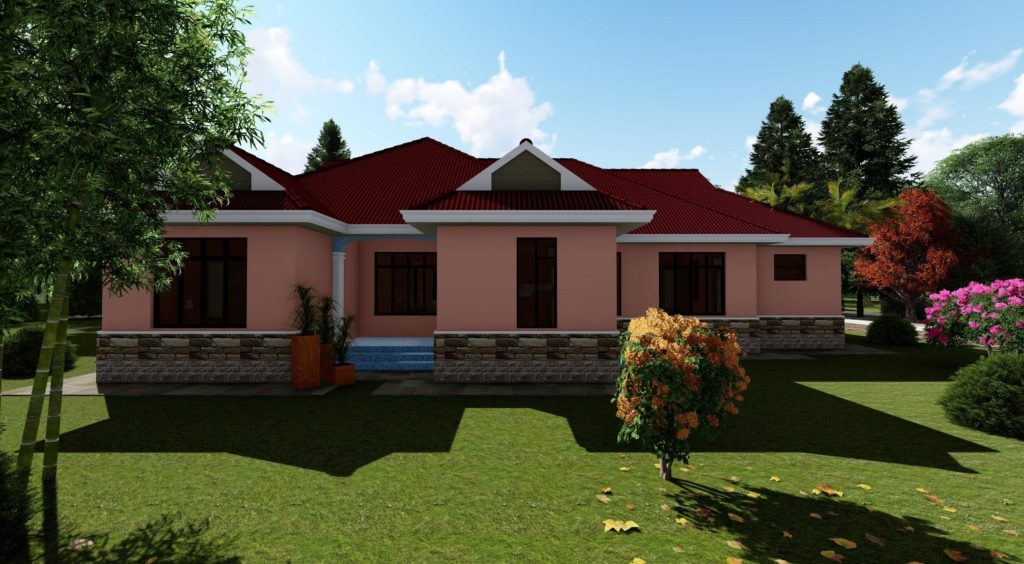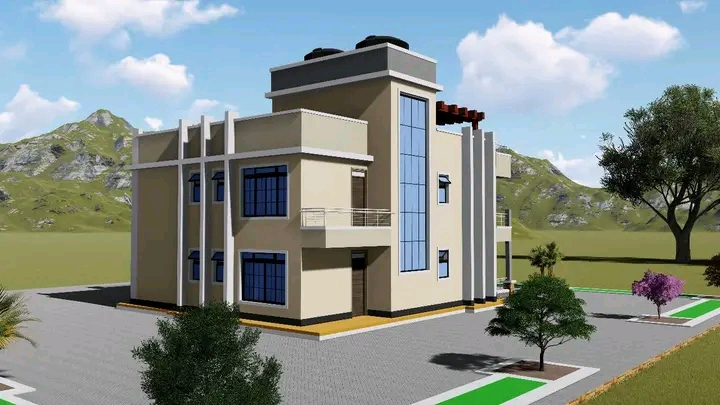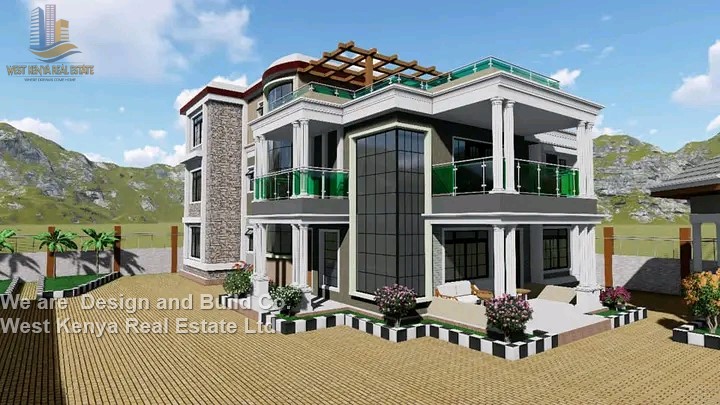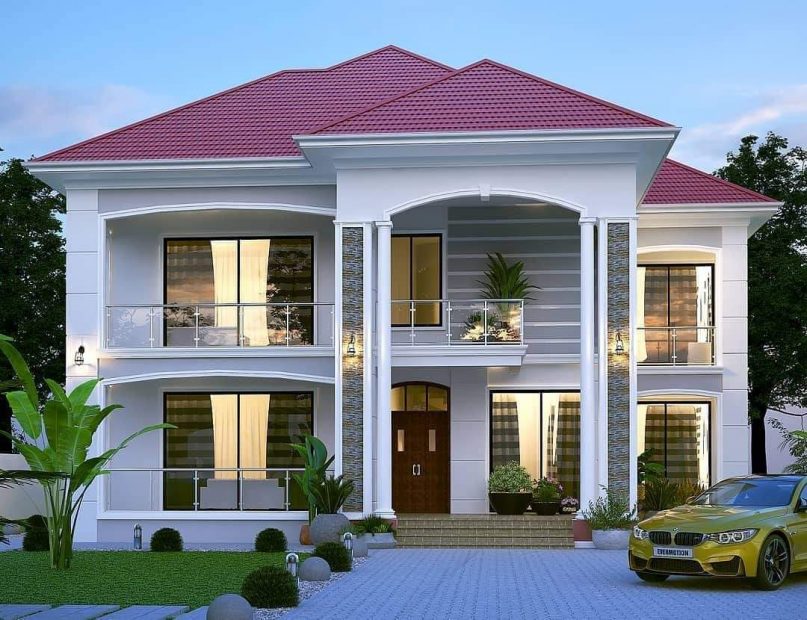The demand for simple house designs in Kenya has been steadily rising as more homeowners seek affordable, practical, and functional housing solutions. With urbanization and population growth, many Kenyans are looking for house designs that can accommodate smaller plots of land, budget constraints, and efficient use of resources. Simple house designs provide an ideal solution, offering cost-effective and straightforward construction methods without sacrificing essential comfort or aesthetic appeal.
One of the key benefits of building simple houses is affordability. These designs often require fewer materials, take less time to construct, and minimize the need for expensive architectural features. This makes them a great option for families looking to build homes within a limited budget. Additionally, simple house designs are typically easier to build, meaning they can be completed faster, reducing labor costs and allowing homeowners to move in sooner.

Functionality is another advantage of simple house designs. By focusing on essential living spaces and efficient layouts, these homes maximize the use of available space, making them ideal for small families or individuals. Simple designs also tend to be more energy-efficient, as they often incorporate natural lighting and ventilation, which reduces the need for artificial cooling or heating.
However, achieving the perfect balance between cost and design is crucial. While it’s important to minimize costs, the quality and aesthetic value of the house should not be overlooked. Simple house designs in Kenya can still offer beauty and style by using clever design elements, such as smart space utilization and thoughtful material choices. This balance ensures that the house is both affordable and visually appealing, catering to the needs of modern homeowners.
Related Keywords: simple house designs in Kenya, affordable house designs in Kenya.
2. Types of Simple House Designs in Kenya
Kenya’s housing landscape offers various simple house designs that cater to different needs, budgets, and locations. From compact urban homes to low-cost rural houses, these designs prioritize functionality and affordability while meeting the specific requirements of different settings. Here are the most common types of simple house designs in Kenya:
1. Small House Designs
Small house designs are becoming increasingly popular, particularly in urban areas where land is limited and expensive. These designs focus on maximizing space efficiency, using smart layouts to ensure that every square meter is functional. Typically, these houses feature open-plan living areas that combine the kitchen, dining, and lounge spaces, creating a sense of openness in a smaller footprint. Small house designs are ideal for single individuals, couples, or small families who want a compact yet comfortable home.
- Features: Compact layouts, open-plan living areas, efficient use of space.
- Best For: Urban homeowners with limited land or small families.
Related Keywords: small house designs in Kenya.
2. Low-Cost Simple House Designs
Low-cost simple house designs focus on affordability without compromising on basic living standards. These designs prioritize the use of locally sourced and affordable materials, such as stone, bricks, or concrete blocks, to reduce construction costs. Additionally, the architectural details are kept minimal, which cuts down on both materials and labor costs. These homes are perfect for homeowners working with a tight budget who want to build a functional and durable house.
- Features: Basic structure, minimal decorative elements, affordable materials.
- Best For: Homeowners looking for cost-effective solutions without sacrificing functionality.
Related Keywords: low cost simple house designs in Kenya, affordable house designs in Kenya.
3. Simple House Designs in Rural Kenya
In rural Kenya, simple house designs often incorporate local construction techniques and materials that are readily available in the area. These designs take into account the specific needs of rural living, such as the availability of land and traditional building methods. Mud, stone, and thatch are commonly used in rural areas to create low-cost but durable homes. Additionally, the designs often emphasize natural ventilation and lighting, reducing the need for costly electrical systems.
- Features: Use of local materials, traditional construction methods, energy efficiency.
- Best For: Rural homeowners seeking affordable, sustainable housing options.
Related Keywords: simple house designs in rural Kenya, low cost simple house designs in Kenya.
These various types of simple house designs offer practical and affordable solutions to meet the needs of diverse homeowners across Kenya, from urban to rural settings. By focusing on space efficiency, low-cost materials, and region-specific techniques, these designs provide functional and attractive homes for a wide range of budgets.
3. Advantages of Simple House Designs
Simple house designs offer a range of benefits that make them an attractive option for many homeowners in Kenya. These designs not only keep costs low but also offer practical solutions that suit various lifestyles and environmental needs. Below are some of the key advantages of choosing simple house designs:
1. Affordability
One of the primary benefits of simple house designs is their affordability. By focusing on essential spaces and cutting down on unnecessary architectural elements, simple designs help reduce the overall building costs. These homes require fewer materials, less labor, and shorter construction timelines, making them a cost-effective option for families on a budget. Additionally, using local and readily available materials such as bricks or concrete blocks further lowers the cost of construction, making affordable house designs in Kenya widely accessible.
- Benefits: Lower material costs, reduced labor expenses, shorter construction time.
- Best For: Homeowners looking for cheap house designs that fit within a limited budget.
Related Keywords: affordable house designs in Kenya, cheap house designs in Kenya.
2. Easy Construction
Another significant advantage of simple house designs is that they are easier and quicker to construct compared to more complex architectural designs. The straightforward nature of these designs eliminates the need for advanced engineering or intricate building techniques, resulting in faster construction timelines. This also means that construction can be completed with fewer skilled workers, reducing labor costs and the complexity of managing the project. The simplicity of the construction process also means there is less room for error, contributing to a smoother building experience.



- Benefits: Faster construction, less complex building process, fewer labor requirements.
- Best For: Homeowners who need to complete their houses quickly and efficiently.
3. Sustainability
Simple house designs also contribute to sustainability by incorporating locally sourced materials and energy-efficient features. Using local materials reduces transportation costs and the carbon footprint associated with construction. Furthermore, these designs often prioritize natural light and ventilation, which reduces the need for artificial lighting and cooling systems. By integrating environmentally friendly building practices, simple house designs can significantly lower both construction costs and the home’s long-term energy consumption.
- Benefits: Lower environmental impact, reduced energy costs, use of sustainable materials.
- Best For: Homeowners looking for low-cost, eco-friendly housing solutions.
Related Keywords: low cost simple house designs in Kenya, affordable house designs in Kenya.
In summary, simple house designs are an excellent option for homeowners who prioritize affordability, ease of construction, and sustainability. These designs offer practical, budget-friendly solutions that meet both the immediate and long-term needs of modern Kenyan homeowners.
4. Design Elements of Beautiful and Affordable Simple Houses
Simple house designs can be both beautiful and functional, even on a limited budget. With the right design elements, homeowners can create aesthetically appealing homes that maximize space and comfort. Here are some key design strategies that ensure beautiful and affordable simple houses in Kenya:
1. Aesthetic Appeal
Creating a visually appealing house doesn’t have to be expensive. Simple designs often emphasize clean lines, minimalistic features, and symmetry, which can create a striking yet budget-friendly appearance. Exterior finishes such as textured walls, neutral color palettes, and natural materials like wood or stone accents can enhance the house’s beauty without exceeding budget limits. Additionally, incorporating elements like well-designed entryways, windows, and porches can add charm to a simple house design.
- Tips: Focus on clean, minimalist designs with strategic use of materials like natural stone or timber to create an elegant look at a low cost.
- Best For: Homeowners looking for beautiful yet affordable house designs in Kenya.
Related Keywords: beautiful house designs in Kenya, beautiful house designs Kenya.
2. Use of Natural Light and Ventilation
One of the most effective ways to enhance the beauty and comfort of a simple house design is by utilizing natural light and ventilation. Large windows, skylights, and strategically placed openings can flood the home with natural light, making it feel more open and spacious. By allowing for natural airflow, these features also help maintain a comfortable indoor climate, reducing the need for artificial cooling or heating. Not only does this improve the aesthetic appeal of the home, but it also lowers energy costs over time.
- Tips: Incorporate large windows, skylights, and cross-ventilation to maximize natural light and airflow.
- Best For: Homeowners aiming for energy-efficient and comfortable homes that feel bright and airy.
Related Keywords: small house designs in Kenya, beautiful house designs Kenya.
3. Maximizing Functionality in Small Spaces
In smaller homes, it’s essential to prioritize functionality in the design. Open-plan layouts that combine the kitchen, dining, and living spaces can make the home feel larger and more connected. Clever storage solutions, such as built-in shelves or multi-purpose furniture, help to minimize clutter and make the most of limited space. Additionally, simple design choices like using light-colored walls, mirrors, and space-saving furniture can create the illusion of more space, enhancing both comfort and aesthetics.
- Tips: Focus on open-plan layouts, smart storage solutions, and the use of light colors to create a spacious, functional home.
- Best For: Homeowners with smaller plots or compact houses who want to maximize space efficiency without compromising on style.
Related Keywords: small house designs in Kenya, affordable house designs in Kenya.
In summary, beautiful and affordable simple houses are achievable with thoughtful design elements that focus on aesthetics, natural light, ventilation, and space efficiency. These strategies ensure that even small or low-cost homes can be functional, comfortable, and visually appealing.
5. Cost Breakdown of Simple House Designs in Kenya
Building a simple house in Kenya involves several factors that determine the overall cost, from land and materials to labor and design choices. Understanding these factors and employing cost-saving strategies can help homeowners stay within budget while ensuring their home meets both functional and aesthetic needs. Below is a breakdown of the main cost factors, typical price ranges, and tips to cut costs effectively.
1. Factors Affecting Cost
Several key factors influence the cost of building a simple house in Kenya:
- Land: The price of land varies significantly depending on the location. Urban areas like Nairobi tend to have higher land costs, while rural areas are generally more affordable. Additionally, factors such as land preparation and access to utilities like water and electricity can add to the total cost.
- Materials: The choice of building materials has a major impact on overall expenses. Locally sourced materials like stone, bricks, and concrete are more affordable and readily available compared to imported materials. The type of roofing, windows, and finishes also influences the final budget.
- Labor: Labor costs depend on the region and the complexity of the design. Simple house designs typically require less specialized labor, which helps keep costs lower. Skilled workers, however, are still necessary to ensure the quality of construction.
- Design Complexity: More intricate designs require more materials, labor, and time, which increases the overall cost. Simple designs with fewer rooms and straightforward layouts help minimize expenses.
Related Keywords: house designs in Kenya and cost, affordable house designs in Kenya.
2. Typical Cost Ranges
The cost of building a simple house in Kenya can vary widely depending on the factors mentioned above, but here are typical price ranges for affordable house designs:
- Small Houses (1-2 Bedrooms): A small house with a simple design can cost between KSh 800,000 and KSh 1.5 million. These homes are ideal for individuals, couples, or small families and typically feature compact layouts with minimal architectural details.
- Medium Houses (3-4 Bedrooms): For a medium-sized house, costs generally range from KSh 1.5 million to KSh 3.5 million. These homes offer more space and may include features like additional rooms or better finishes, while still maintaining an affordable structure.
- Rural Homes: In rural areas, the cost of building a simple house can be significantly lower, often starting at around KSh 500,000 for a basic structure. Using local materials and traditional construction methods further reduces the price.
Related Keywords: cheap house plans in Kenya, house designs in Kenya and cost.
3. Cost-Saving Tips
There are several ways to reduce construction costs without compromising on the quality or functionality of the home:
- Use Local Materials: Opt for materials that are locally sourced and readily available to cut down on transportation costs. Stone, brick, and concrete are affordable and durable options in Kenya.
- Simple Layouts: Stick to straightforward house designs with fewer rooms and avoid complex architectural features like curved walls or high ceilings, which can increase material and labor costs.
- Efficient Space Utilization: Design the home to maximize the use of available space, allowing you to build a smaller house without sacrificing functionality. Open-plan designs, for example, can make the house feel more spacious while using less square footage.
- DIY and Low-Cost Finishes: Where possible, take on smaller projects yourself, such as painting or landscaping, to reduce labor costs. Additionally, opting for cost-effective yet durable finishes can help save money.
Related Keywords: affordable house designs in Kenya, cheap house plans in Kenya.
In conclusion, by considering factors such as land, materials, and labor, homeowners can estimate the cost of building a simple house in Kenya. With thoughtful design choices and cost-saving strategies, it’s possible to create a beautiful and functional home without exceeding the budget.
6. Popular Simple House Plans in Kenya
Simple house plans are becoming increasingly popular in Kenya due to their affordability, practicality, and ability to adapt to various family sizes and budgets. Whether you’re building a home for a small family or planning for future growth, these house plans offer flexibility and functionality. Here are some of the most common simple house plans available in Kenya:
1. One-Bedroom and Two-Bedroom House Plans
One-bedroom and two-bedroom house plans are ideal for individuals, couples, or small families looking for affordable and compact living spaces. These homes typically feature open-plan designs that maximize the available space, ensuring functionality without requiring a large plot of land. One-bedroom and two-bedroom houses are often more affordable to construct and maintain, making them a great option for first-time homeowners or those on a limited budget.
- Features: Compact design, open-plan living spaces, efficient use of small areas.
- Best For: Small families, single occupants, or young couples.
Related Keywords: cheap house plans in Kenya, small house designs in Kenya.
2. Bungalows
Bungalows are simple, single-story house designs that are popular in both rural and urban settings. They are easy to construct, maintain, and expand, making them an excellent choice for families who prefer a straightforward and accessible living space. Bungalows often feature large verandas, open-plan living areas, and multiple bedrooms, depending on the size. Their single-story design also makes them suitable for homeowners who prefer not to have stairs, such as elderly individuals or families with young children.
- Features: Single-story layout, large verandas, open-plan living areas, adaptable for rural and urban settings.
- Best For: Families who prefer a traditional home design with easy accessibility.
Related Keywords: home designs in Kenya, small house designs in Kenya.
3. Expandable House Plans
Expandable house plans are a flexible solution for homeowners who want to start with a small house and expand as their needs or budget allows. These designs are ideal for families that plan to grow or for homeowners who want to invest in stages. The initial structure typically includes essential rooms, such as bedrooms, a kitchen, and a bathroom, with provisions for future expansions like additional bedrooms, living spaces, or even a second floor.
- Features: Modular design, provision for future expansion, cost-effective for gradual development.
- Best For: Homeowners looking to build in phases, accommodating family growth or financial planning.
Related Keywords: cheap house plans in Kenya, home designs in Kenya.
In summary, simple house plans like one-bedroom and two-bedroom homes, bungalows, and expandable designs are popular choices in Kenya due to their flexibility, affordability, and ease of construction. Whether you’re looking to build a compact house for a small family or a bungalow with the potential for future growth, these house plans offer practical solutions for a wide range of homeowners.
7. Building Simple Houses in Rural vs. Urban Kenya
The process of building simple houses in Kenya varies significantly between rural and urban areas, mainly due to differences in available resources, land size, and infrastructure. Understanding the unique challenges and adaptations required for each environment is essential to creating functional and affordable house designs that meet the needs of homeowners.
1. Challenges in Rural Areas
Building a simple house in rural Kenya presents several challenges, particularly in terms of access to materials, skilled labor, and infrastructure. While rural areas generally offer more affordable land, these other factors can significantly affect the cost and timeline of construction.
- Access to Materials: Rural areas often have limited access to a wide range of building materials. The need to transport materials from urban centers can increase both time and costs. However, many rural builders rely on locally available materials like stone, clay, or timber, which can help reduce expenses. Using traditional methods with local materials allows homeowners to build within budget while maintaining the structural integrity of their homes.
- Skilled Labor: The availability of skilled workers, such as architects or professional builders, may be limited in rural areas. This can lead to a reliance on local artisans who may have variable levels of expertise. It’s important to plan ahead and hire skilled professionals for key elements like foundation work, roofing, and electrical installations to ensure safety and durability.
- Infrastructure: Rural areas often lack access to basic infrastructure like roads, electricity, or reliable water sources. As a result, alternative solutions like solar energy systems, rainwater harvesting, and off-grid sanitation systems may be required, adding to the overall cost of construction. However, these sustainable solutions can reduce long-term operational costs for homeowners.
- Design Adaptations: Simple house designs in rural Kenya often incorporate natural ventilation, local climate considerations, and energy-efficient features. For example, large windows for cross-ventilation, rainwater collection systems, and using traditional techniques like thatched roofs can improve sustainability and adapt to local conditions.
Related Keywords: simple house designs in rural Kenya, affordable house designs in Kenya.
2. Urban Adaptations
Building in urban areas comes with a different set of challenges, primarily related to limited land availability and higher costs for services. However, the proximity to suppliers, skilled labor, and infrastructure generally makes the construction process more streamlined in urban settings.
- Smaller Plots: One of the main constraints in urban environments is the availability of land, often leading to smaller, more compact plots. Simple house designs in these areas need to be highly efficient in their use of space. Solutions like multi-story homes, open-plan living areas, and maximizing vertical space allow homeowners to build within smaller footprints while maintaining functionality and comfort.
- Access to Materials and Labor: Urban areas generally have better access to a wide variety of building materials, including prefabricated materials and eco-friendly options, which can simplify construction. Additionally, skilled labor, such as contractors, architects, and engineers, is more readily available in urban centers, allowing for more specialized and professional construction services. This can result in faster project completion and higher quality work.
- Infrastructure: Urban homes typically have access to essential utilities like electricity, water, and sewage systems, which simplifies the construction and reduces the need for alternative solutions. However, these services may come at a higher cost due to utility connection fees and higher land prices.
- Design Considerations: Simple house designs in urban environments can incorporate features like rooftop gardens, terraces, and compact gardens to maximize outdoor living space. Modular designs and multi-functional rooms also allow homeowners to adapt their living spaces to changing needs over time, ensuring that even small plots can support practical and modern living.
Related Keywords: affordable house designs in Kenya, simple house designs in rural Kenya.
8. Conclusion
Simple house designs in Kenya offer numerous benefits, making them a practical and affordable choice for many homeowners. Their affordability, ease of construction, and adaptability to both rural and urban settings make them an ideal solution for individuals and families looking for functional and attractive housing. These designs focus on essential spaces, cost-effective materials, and thoughtful layouts, helping homeowners build within budget without compromising quality.
Whether you’re building in rural areas with local materials or tackling space constraints in urban environments, simple house designs provide a range of options to suit your needs. From compact one-bedroom homes to expandable designs, there are numerous choices that balance beauty, functionality, and budget.
Call to action: For homeowners looking to create cost-effective and beautiful homes, consulting with experienced architects and builders is essential. They can help you select the right design that meets your requirements, ensuring that your dream home is both affordable and practical.
Related Keywords: simple house designs in Kenya, affordable house designs in Kenya, beautiful house designs Kenya.
This conclusion wraps up the discussion on simple house designs in Kenya, encouraging readers to explore their options while incorporating the relevant keywords throughout the content naturally.





6 thoughts on “Simple House Designs in Kenya”